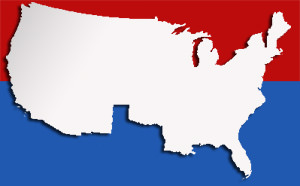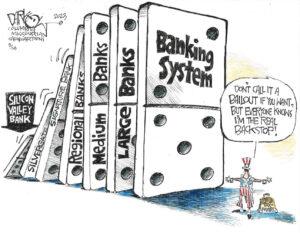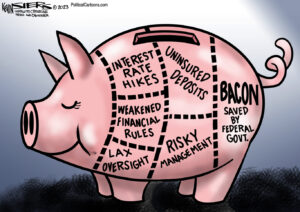The New Secessionists
The difference between the tea party and the secessionist movement bubbling up in some two dozen states is that the tea party believes America can be fixed.
Editor’s note: Because of an error, Chris Hedges’ April 25 column used part of a sentence that appeared in a recent article by Christopher Ketcham in GOOD magazine and on its website. Truthdig acknowledges Ketcham’s work and regrets the failure to properly attribute the wording to him. Ketcham is credited in the revised column below.
Acts of rebellion which promote moral and political change must be nonviolent. And one of the most potent nonviolent alternatives in the country, which defies the corporate state and calls for an end to imperial wars, is the secessionist movement bubbling up in some two dozen states including Vermont, Texas, Alaska and Hawaii.
These movements do not always embrace liberal values. Most of the groups in the South champion a “neo-Confederacy” and are often exclusively male and white. Secessionists, who call for statewide referendums to secede, do not advocate the use of force. It is unclear, however, if some will turn to force if the federal structure ever denies them independence.
These groups at least grasp that the old divisions between liberals and conservatives are obsolete and meaningless. They understand that corporations have carried out a coup d’état. They recognize that our permanent war economy and costly and futile imperial wars are unsustainable and they demand that we take popular action to prevent citizens from being further impoverished and robbed by Wall Street speculators and corporations.
“The defining characteristic of the Second Vermont Republic is that there are two enemies, the United States government and corporate America,” Thomas Naylor, who founded Vermont’s secessionist movement, told me when I reached him by phone at his home 10 miles south of Burlington. “One owns the other one. We are not like the tea party. The underlying premise of the tea party movement is that the system is fixable.”
As reported by Christopher Ketcham in a recent issue of GOOD magazine, Naylor points to the nation’s decline. The secessionist leader notes, in Ketcham’s words, “Of all the western democracies, the United States stands near dead last in voter turnout, last in health care, last in education, highest in homicide rates, mortality, STDs among juveniles, youth pregnancy, abortion, and divorce. …”
The nation, he says grimly, has trillions in deficits it can never repay, is beset by staggering income disparities, has destroyed its manufacturing base and is the planet’s most egregious polluter and greediest consumer of fossil fuels. With some 40 million Americans living in poverty, tens of millions more in a category called “near poverty” and a permanent underclass trapped by a real unemployment rate of 17 percent, there is ample tinder for internal combustion. If we do not undertake a dramatic reversal soon, he asserts, the country and the global environment will implode with catastrophic consequences.
The secessionist movement is gaining ground in several states, especially Texas, where elected officials increasingly have to contend with secessionist sentiments.
“Our membership has grown tremendously since the bailouts, since the tail end of the Bush administration,” said Daniel Miller, the leader of the Texas Nationalist Movement, when I spoke with him by telephone from his home in the small town of Nederland, Texas. “There is a feeling in Texas that we are being spent into oblivion. We are operating as the cash cow for the states that cannot manage their budgets. With this Congress, Texas has been squarely in their cross hairs, from cap and trade to the alien transfer and exit program. So many legislative pieces coming down the pike are offensive to people here in Texas. The sentiment for independence here is very high. The sentiment inside the Legislature and state capital is one of guarded optimism. There are scores of folks within state government who are supportive of what we are doing, although there is a need to see the public support in a more tangible way. This is why we launched our Let Texas Decide petition drive. We intend to deliver over a million signatures on the opening day of the [state legislative] session on Jan. 11, 2011.”
Miller, like Naylor, expects many in the tea party to migrate to secessionist movements once they realize that they cannot alter the structure or power of the corporate state through electoral politics. Polls in Texas show the secessionists have support from about 35 percent of the state’s population, and Vermont is not far behind.
Naylor, who taught economics at Duke University for 30 years, is, along with Kirkpatrick Sale and Donald Livingston, one of the intellectual godfathers of the secessionist movement. His writing can be found on The Second Vermont Republic website, on the website Secession News and in postings on the Middlebury Institute website. Naylor first proposed secession in his 1997 book “Downsizing the USA.” He comes out of the “small is beautiful” movement, as does Sale. Naylor lives with his wife in the Vermont village of Charlotte.
The Second Vermont Republic arose from the statewide anti-war protests in 2003. It embraces a left-wing populism that makes it unique among the national movements, which usually veer more toward Ron Paul libertarianism. The Vermont movement, like the Texas and Alaska movements, is well organized. It has a bimonthly newspaper called The Vermont Commons, which champions sustainable agriculture and energy supplies based on wind and water, and calls for locally owned banks which will open lines of credit to their communities. Dennis Steele, who is campaigning for governor as a secessionist, runs Radio Free Vermont, which gives a venue to Vermont musicians and groups as well as being a voice of the movement. Vermont, like Texas, was an independent republic, but on March 4, 1791, voted to enter the union. Supporters of the Second Vermont Republic commemorate the anniversary by holding a mock funeral procession through the state capital, Montpelier, with a casket marked “Vermont.” Secessionist candidates in Vermont are currently running for governor, lieutenant governor, eight Senate seats and two House seats.“The movement, at its core, is anti-authoritarian,” said Sale, who works closely with Naylor and spoke with me from his home in Charleston, S.C. “It includes those who are libertarians and those who are on the anarchic community side. In traditional terms these people are left and right, but they have come very close together in their anti-authoritarianism. Left and right no longer have meaning.”
The movement correctly views the corporate state as a force that has so corrupted the economy, as well as the electoral and judicial process, that it cannot be defeated through traditional routes. It also knows that the corporate state, which looks at the natural world and human beings as commodities to be exploited until exhaustion or collapse occurs, is rapidly cannibalizing the nation and pushing the planet toward irrevocable crisis. And it argues that the corporate state can be dismantled only through radical forms of nonviolent revolt and the dissolution of the United States. As an act of revolt it has many attributes.
“The only way we will ever stop these wars is when we stop paying for them,” Naylor told me. “Vermont contributes about $1.5 billion to the Pentagon’s budget. Do we want to keep supporting these wars? If not, let’s pull out. We have two objectives. The first is returning Vermont to its status as an independent republic. The second is the peaceful dissolution of the empire. I see these as being mutually complementary.”
“The U.S. government has lost its moral authority,” he went on. “It is corrupt to the core. It is owned, operated and controlled by Wall Street and corporate America. Its foreign policy is controlled by the Israeli lobby. It is unsustainable economically, socially, morally, militarily and environmentally. It is ungovernable and therefore unfixable. The question is, do you go down with the Titanic or do you seek other options?”
The leaders of the movement concede that sentiment still outstrips organization. There has not been a large proliferation of new groups, and a few old groups have folded because of a lack of leadership and support. But they insist that an increasing number of Americans are receptive to their ideas.
“The number of groups has not grown as I hoped it would when I started having congresses,” said Sale, who addresses groups around the country. “But the number of people, of individuals, of websites and the number of libertarians who have come around has grown leaps and bounds. Many of those who were disappointed by the treatment of Ron Paul have come to the conclusion that they cannot have a Libertarian Party or a libertarian Republican. They are beginning to talk about secession.”
“Secessionists have to be very careful not to be militaristic,” Sale warned. “This cannot be won by the gun. You can be emphatic in your secessionism, but it won’t happen by carrying guns. I don’t know what the tea party people think they are going to accomplish with guns. I guess it is a statement against the federal government and the fear that Obama is about to have gun control. It appears to be an assertion of individual rights. But the tea party people have not yet understood how they are going to get their view across. They still believe they can elect people, either Republicans or declared conservatives, to office in Washington and have an effect, as if you can escape the culture of Washington and the characteristics of government that has only gotten bigger and will only continue to get bigger. Electing people to the House and Senate is not going to change the characteristics of the system.”
The most pressing problem is that the movement harbors within its ranks Southern secessionists who wrap themselves in the Confederate flag, begin their meetings singing Dixie and celebrate the slave culture of the antebellum South. Secessionist groups such as the Southern National Congress and the more radical League of the South, which the Southern Poverty Law Center has labeled a “racist hate group,” openly embrace a return to uncontested white, male power. And this aspect of the movement deeply disturbs leaders such as Naylor, Sale and Miller.
What all these movements grasp, however, is that the American empire is over. It cannot be sustained. They understand that we must disengage peacefully, learn to speak with a new humility and live with a new simplicity, or see an economic collapse that could trigger a perverted Christian fascism, a ruthless police state and internecine violence.
“There are three or four possible scenarios that will bring down the empire,” Naylor said. “One possibility is a war with Iran. Another will see the Chinese pull the plug on Treasury bills. Even if these do not happen, the infrastructure of the country is decaying. This is a slower process. And they do not have the economy fixed. It is smoke and mirrors. This is why the price of gold is so high. The economy and the inability to stop the wars will alone be enough to bring us down. There is no escape now from our imperial overstretch.”
Your support matters…Independent journalism is under threat and overshadowed by heavily funded mainstream media.
You can help level the playing field. Become a member.
Your tax-deductible contribution keeps us digging beneath the headlines to give you thought-provoking, investigative reporting and analysis that unearths what's really happening- without compromise.
Give today to support our courageous, independent journalists.




You need to be a supporter to comment.
There are currently no responses to this article.
Be the first to respond.